The Autonomous Drone Platform Market is estimated to be valued at USD 10.6 billion in 2025 and is projected to reach USD 35.4 billion by 2035, registering a compound annual growth rate (CAGR) of 12.8% over the forecast period.
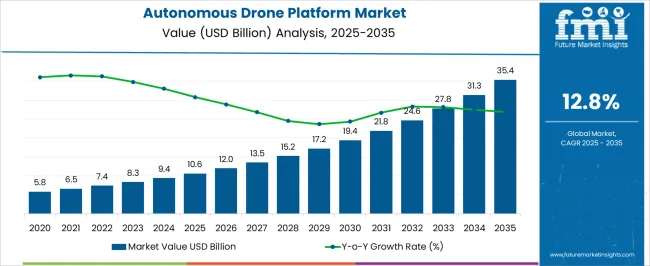
| Metric | Value |
|---|---|
| Autonomous Drone Platform Market Estimated Value in (2025 E) | USD 10.6 billion |
| Autonomous Drone Platform Market Forecast Value in (2035 F) | USD 35.4 billion |
| Forecast CAGR (2025 to 2035) | 12.8% |
The autonomous drone platform market is evolving rapidly, fueled by advancements in artificial intelligence, navigation systems, and edge computing technologies. These platforms are gaining traction across industries due to their ability to perform complex tasks with minimal human intervention, such as real time surveillance, precision agriculture, and infrastructure assessment.
Regulatory frameworks are gradually adapting to accommodate autonomous aerial operations, further opening the market for commercial and enterprise applications. The growing need for cost effective, high precision, and safe alternatives to manual inspection or monitoring processes is driving adoption.
Enhanced payload capacities, longer flight durations, and integration with cloud based analytics are enabling wider applicability across sectors. The market is set to grow steadily as enterprises across agriculture, infrastructure, and logistics turn to autonomous drone systems for scalability, operational efficiency, and data driven decision making.
The market is segmented by Industry, Application, and Enterprise Size and region. By Industry, the market is divided into Agriculture, Aerial Photography, Emergency Management, Inspection and Monitoring, Remote Sensing & Mapping, Wildlife Research, and Others. In terms of Application, the market is classified into Infrastructure Inspection, Surveying, Agriculture, Photography and Videography, Defense & Military, and Others. Based on Enterprise Size, the market is segmented into Small Office Employees (1-9 employees), Small Enterprises (10-99 employees), Medium-sized Enterprises (100-499 employees), Large Enterprises (500-999), and Very Large Enterprises (1000+ employees). Regionally, the market is classified into North America, Latin America, Western Europe, Eastern Europe, Balkan & Baltic Countries, Russia & Belarus, Central Asia, East Asia, South Asia & Pacific, and the Middle East & Africa.
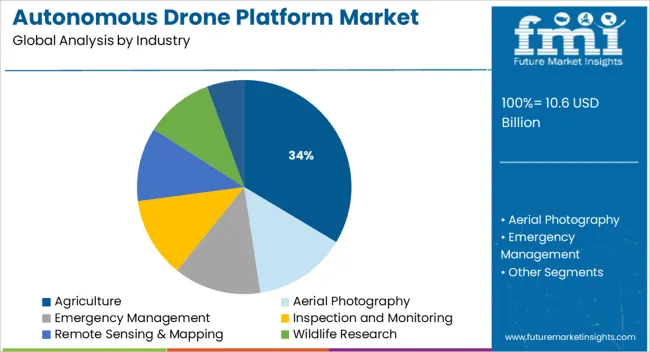
The agriculture industry segment is projected to represent 33.60% of total revenue by 2025, making it the leading sector in terms of end use. This dominance is driven by the sector’s increasing dependence on precision farming practices, which demand accurate data collection and crop monitoring capabilities.
Autonomous drone platforms are being utilized for soil analysis, irrigation monitoring, yield estimation, and pest detection, offering farmers real time insights that improve decision making and resource efficiency. The growing global focus on sustainable agriculture and food security has also supported the integration of drone technology in farming operations.
As adoption spreads from large agribusinesses to small and medium farms, the agriculture segment continues to lead due to its consistent need for scalable and technology driven solutions.
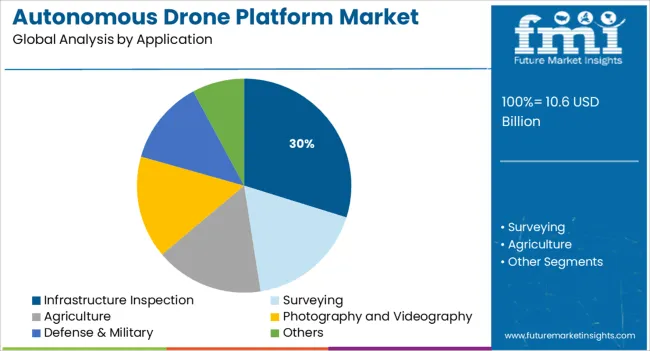
The infrastructure inspection segment is expected to account for 29.80% of total market revenue by 2025 within the application category, positioning it as a leading use case. This growth is being propelled by increased demand for safer, more efficient, and cost effective methods of assessing structural integrity in sectors such as energy, transportation, and construction.
Autonomous drone platforms eliminate the need for manual inspection in hazardous or hard to reach locations, reducing risk and downtime. They enable high resolution imaging, thermal analysis, and real time defect detection, improving maintenance planning and asset management.
As governments and private infrastructure operators prioritize safety compliance and lifecycle management, the role of autonomous drone platforms in routine inspections continues to expand, supporting the segment’s upward trajectory.
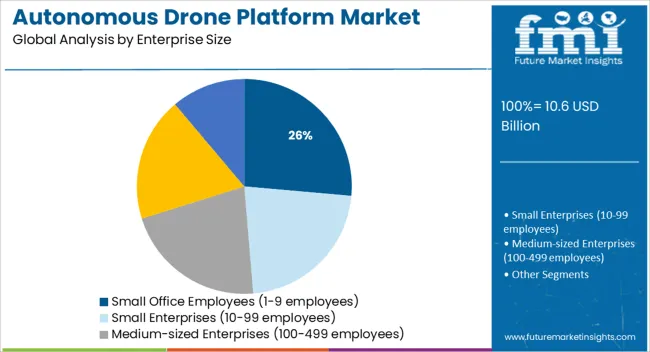
The small office employees segment comprising enterprises with one to nine employees is projected to hold 26.40% of the total market revenue by 2025, leading the enterprise size category. This growth is influenced by the accessibility of cost efficient autonomous drone platforms tailored for niche business use.
Small enterprises in sectors such as agriculture, land surveying, and event videography are increasingly integrating these platforms to gain competitive advantage without the overhead of large operational teams. The plug and play nature of current drone systems and availability of cloud based data analytics have made adoption easier for non technical users.
As digital tools become more user friendly and affordable, small scale businesses are leveraging autonomous drone platforms to enhance productivity, driving the leadership of this segment within the market.
Drones can take the place of conventional ways of operation in many commercial operations. This development follows the Federal Aviation Administration's expansion of drone usage authorizations for commercial, non-hobbyist use.
Moreover, drones can save time and money, as they require fewer humans to operate and lack safety infrastructure. Additionally, they can improve data analytics, which helps businesses understand and forecast operating performance. The adoption of autonomous drones platform even opens up new business models and prospects in some sectors.
The majority of the value is created by services that operate and maintain drones for businesses. End-user businesses hand over to outside parties the operations, data management, and maintenance of drones. For instance, telecommunications companies may end up selling drone data communications services to direct drones and send the data they collect.
The vast commercial market potential, the falling costs of drone parts (such as sensors and batteries), and technological advancements in artificial intelligence (AI) and analytics are the primary motivators for investments in the autonomous drone platform market.
These factors have led to a steady increase in market share. For instance, as of June 2020, 52 trades totaling USD 216 million have been seen, surpassing the annual total of 2014 by 11 deals and USD 52 million in the market. At the current run rate, deals involving USD 506 million in investment are anticipated to reach a record high of 122.
Furthermore, it is anticipated that the market continues to rise as a result of the main players' growing investments in the drone business, like Amazon and Google.
| Attributes | Details |
|---|---|
| Autonomous Drone Platform Market CAGR (2025 to 2035) | 12.8% |
| Autonomous Drone Platform Market Size (2025) | USD 8.3 billion |
| Autonomous Drone Platform Market Size (2035) | USD 24.9 billion |
Moreover, revenue generation in the market expanded at a 12.7% CAGR from 2020 to 2025. With a value of USD 10.6 billion in 2025, the market is seeing lucrative opportunities and is expected to reach USD 24.9 billion by 2035.
Earlier drones have a specified application in military operations, such as surveillance, reconnaissance, and target acquisition. These drones are equipped with advanced sensors and cameras to provide real-time data to military personnel. For instance, the USA Air Force is using MQ-9 Reaper drones for surveillance and intimidation of enemies.
However, sales of autonomous drone platforms are becoming common in the commercial sector due to technological improvements. Due to this, it is predicted that in the short run, demand for autonomous drone platforms is likely to expand quickly, reaching USD 17.2 billion by 2029.
Increased Demand for Miniaturization
Drones that can fly independently without human control have been developed as a result of the increased desire for drones to be miniature. Compared to manually controlled drones, autonomous drones are capable of doing tasks like surveillance, mapping, and delivery in a safer and more effective way.
Introduction of GPS and Sensors
GPS and other navigational sensors are major reasons behind the high sales of autonomous drone platforms. Due to the elimination of the necessity for a pilot, commercial users are now more likely to be interested in autonomous drone platforms.
Swarm Intelligence
Swarm intelligence uses AI to plan the actions of hundreds or thousands of robots, imitating the way some groups of animals cooperate, enabling drones to collectively compete in increasingly difficult jobs.
Currently, humans train collaborative robots, but that day is quickly approaching when robots are able to think by themselves and instruct one another. Drone squadrons can simultaneously perform specific jobs and cover large geographic areas. Swarm intelligence encourages the autonomous drone platform market share further.
Agriculture Industry dominated the market with a share of 20.1% in 2024. It is expected to have a CAGR of 4.9% during the forecast period.
The increasing demand for drone-assisted agricultural automation and crop monitoring is providing new opportunities to autonomous drone platform manufacturers. They are employed in farming processes like crop scouting, crop mapping, crop spraying, and plant health monitoring, among others.
Increasing investments in agricultural technology, rising demand for precision farming, and government programs to encourage the use of autonomous drones are some of the major market growth drivers.
The availability of cutting-edge technologies like artificial intelligence, machine learning, and computer vision, as well as the increasing demand for crop monitoring and the need to lower the cost of farming operations, are all contributing to the autonomous drone platform market share.
Defense and military, where the adoption of autonomous drone platforms is at its highest, with a market share of 25.8% in 2024.
The need for autonomous drone systems in military and defense applications has considerably increased in recent years. Unmanned aerial vehicles (UAVs) that can complete missions with little to no human intervention are popular in this sector.
Additionally, the growing demand for unmanned aerial systems (UASs) for lengthy flights and the expanding use of UAVs for border surveillance, search and rescue missions, and military activities are anticipated to propel market growth.
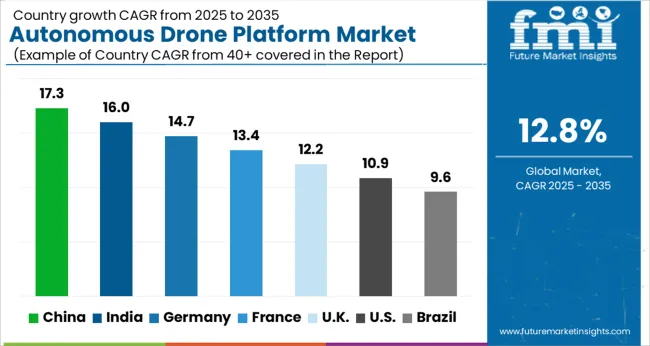
The USA dominated the North American autonomous drone platform market with a share of 13.4% in 2024.
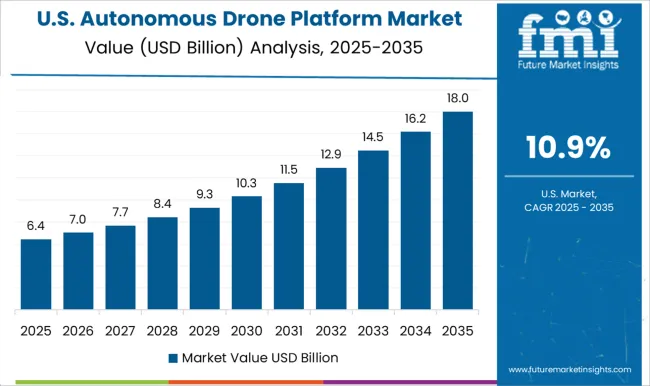
Over the projected period, it is anticipated that the United States would employ a more autonomous drone platform. This is brought on by the rise in demand for autonomous drone platforms for industrial, commercial, and government uses.
Additionally, the USA government has taken action to encourage the use of autonomous drone platforms for a range of tasks, including monitoring and surveillance, package delivery, and search and rescue operations. It is anticipated that rising research and development efforts in the area of autonomous drone platforms further fuel market expansion.
For example, the USA Air Force launched a project in 2024 that was centered on the creation of autonomous drone systems. The project's objective was to create a drone platform that could be utilized for surveillance and reconnaissance missions.
In addition, rising investments in the commercial and defense sectors are anticipated to fuel market expansion in North America.

The demand for autonomous drone platform has grown in Germany, with a share of 10.3% in 2024. This is attributed to the developments in drone technology, including obstacle avoidance systems and autonomous navigation capabilities.
In addition, the growing need for commercial drone services from the government and other public and private entities is anticipated to propel market expansion in Germany. DJI, Yuneec, senseFly, Parrot, and Autel Robotics are the market leaders in Germany for autonomous drone platform. To meet the needs of different consumers, these businesses provide a wide range of goods, including fixed-wing and multirotor platform.
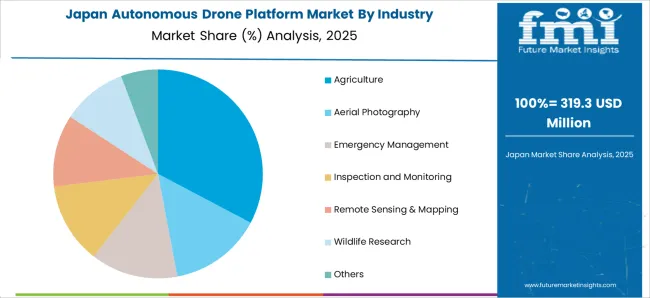
The demand for inspection, monitoring, and delivery services using drones is likely to grow, which would help the Japanese market for autonomous drone platform expand. The industry is also expanding, with a share of 5.5% as a result of the military and defense industries' increasing desire for drones.
Moreover, the Japanese government has also made steps to encourage drone use in the nation. The U-space project, started by the government, proposes to use of drones in the logistics and transportation industries.
In order to aid in the development of drone-related goods and services in Japan, the government has also established the Drone Fund. SoftBank, NEC Corporation, Skycatch, Autel Robotics, and DJI are the leading companies active in the Japanese market for autonomous drone platform.
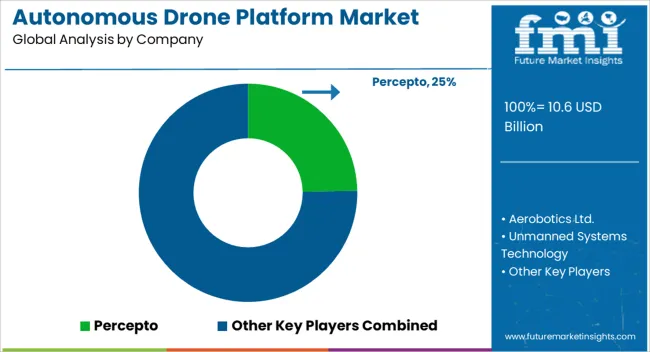
Major Corporate Ventures Primarily Support the Market Share and Encourage Start-Ups to Enter Into the Industry.
Most investments have not yet resulted in the anticipated exits or IPOs, as the industry is still relatively new. There have been 34 exits and IPOs since 2012, and more are anticipated in the following years.
With more than two-thirds of corporate deals during the previous five quarters occurring at the seed or series A level, the financings have likewise tended to favor early-stage businesses.
Moreover, corporate initiatives are seeking to penetrate particular markets or to gain expertise in particular fields, such as detect-and-avoid capabilities, which would give drones the "sense" to avoid collisions and safely complete their missions.
A few enterprises competing for market share become de facto standards, while the remaining businesses are squeezed out as a result of consolidation.
| Companies | Ventures |
|---|---|
| Qualcomm Ventures | The most active venture capitalist, having invested in six businesses thus far, including those involved in mapping, pipe inspection, distribution, 3D mapping, autonomous solutions, and business solutions. In order to advance their cellular technology inside drone operations and introduce their own robotics business solutions, Qualcomm also bought Kmel Robotics. |
| Google Venture | Google Venture has also made significant investments in 3D mapping, end-to-end commercial solutions, and long-range delivery. 63 drone-related patents from Google Ventures have been created, covering a range of drone capabilities. |
| Intel Venture | It has made investments in a hardware firm, an analytics solution, and an entire end-to-end commercial solution. Additionally, they bought two businesses: Ascending Technologies, which creates "sense and avoid" algorithms, and MaVinci, which creates flight planning software. These investments and acquisitions have helped Intel build its own commercial drone application solutions. |
To create more sophisticated features and capabilities, autonomous drone platform manufacturers work with software creators, hardware manufacturers, and other drone industry partners. By doing so, they are able to outperform the competition and provide their clients with better value.
The global autonomous drone platform market is estimated to be valued at USD 10.6 billion in 2025.
The market size for the autonomous drone platform market is projected to reach USD 35.4 billion by 2035.
The autonomous drone platform market is expected to grow at a 12.8% CAGR between 2025 and 2035.
The key product types in autonomous drone platform market are agriculture, aerial photography, emergency management, inspection and monitoring, remote sensing & mapping, wildlife research and others.
In terms of application, infrastructure inspection segment to command 29.8% share in the autonomous drone platform market in 2025.






Our Research Products

The "Full Research Suite" delivers actionable market intel, deep dives on markets or technologies, so clients act faster, cut risk, and unlock growth.

The Leaderboard benchmarks and ranks top vendors, classifying them as Established Leaders, Leading Challengers, or Disruptors & Challengers.

Locates where complements amplify value and substitutes erode it, forecasting net impact by horizon

We deliver granular, decision-grade intel: market sizing, 5-year forecasts, pricing, adoption, usage, revenue, and operational KPIs—plus competitor tracking, regulation, and value chains—across 60 countries broadly.

Spot the shifts before they hit your P&L. We track inflection points, adoption curves, pricing moves, and ecosystem plays to show where demand is heading, why it is changing, and what to do next across high-growth markets and disruptive tech

Real-time reads of user behavior. We track shifting priorities, perceptions of today’s and next-gen services, and provider experience, then pace how fast tech moves from trial to adoption, blending buyer, consumer, and channel inputs with social signals (#WhySwitch, #UX).

Partner with our analyst team to build a custom report designed around your business priorities. From analysing market trends to assessing competitors or crafting bespoke datasets, we tailor insights to your needs.
Supplier Intelligence
Discovery & Profiling
Capacity & Footprint
Performance & Risk
Compliance & Governance
Commercial Readiness
Who Supplies Whom
Scorecards & Shortlists
Playbooks & Docs
Category Intelligence
Definition & Scope
Demand & Use Cases
Cost Drivers
Market Structure
Supply Chain Map
Trade & Policy
Operating Norms
Deliverables
Buyer Intelligence
Account Basics
Spend & Scope
Procurement Model
Vendor Requirements
Terms & Policies
Entry Strategy
Pain Points & Triggers
Outputs
Pricing Analysis
Benchmarks
Trends
Should-Cost
Indexation
Landed Cost
Commercial Terms
Deliverables
Brand Analysis
Positioning & Value Prop
Share & Presence
Customer Evidence
Go-to-Market
Digital & Reputation
Compliance & Trust
KPIs & Gaps
Outputs
Full Research Suite comprises of:
Market outlook & trends analysis
Interviews & case studies
Strategic recommendations
Vendor profiles & capabilities analysis
5-year forecasts
8 regions and 60+ country-level data splits
Market segment data splits
12 months of continuous data updates
DELIVERED AS:
PDF EXCEL ONLINE
Autonomous Driving Virtual Simulation Platform Market Forecast and Outlook 2025 to 2035
Autonomous Driving Simulation Tester Market Size and Share Forecast Outlook 2025 to 2035
Autonomous Aerial Robot Market Size and Share Forecast Outlook 2025 to 2035
Drone Test Stand Market Size and Share Forecast Outlook 2025 to 2035
Autonomous Ultrasound Guidance Market Analysis - Size, Share, and Forecast Outlook 2025 to 2035
Autonomous Imaging Market Size and Share Forecast Outlook 2025 to 2035
Autonomous AI Powered Ophthalmology Screening Market Size and Share Forecast Outlook 2025 to 2035
Autonomous Radiology Systems Market Size and Share Forecast Outlook 2025 to 2035
Autonomous Agents Market Size and Share Forecast Outlook 2025 to 2035
Drone Simulator Market Size and Share Forecast Outlook 2025 to 2035
Autonomous Parking Market Size and Share Forecast Outlook 2025 to 2035
Autonomous Trucks Market Size and Share Forecast Outlook 2025 to 2035
Drones For Emergency Responders Market Size and Share Forecast Outlook 2025 to 2035
Drone Inspection and Monitoring Market Size and Share Forecast Outlook 2025 to 2035
Drone Cybersecurity Market Size and Share Forecast Outlook 2025 to 2035
Platform Lifts Market Size and Share Forecast Outlook 2025 to 2035
Drone Logistics & Transportation Market Size and Share Forecast Outlook 2025 to 2035
Platform Architecture Market Size and Share Forecast Outlook 2025 to 2035
Drone Warfare Market Size and Share Forecast Outlook 2025 to 2035
Drone Analytics Market Size and Share Forecast Outlook 2025 to 2035

Thank you!
You will receive an email from our Business Development Manager. Please be sure to check your SPAM/JUNK folder too.
Chat With
MaRIA